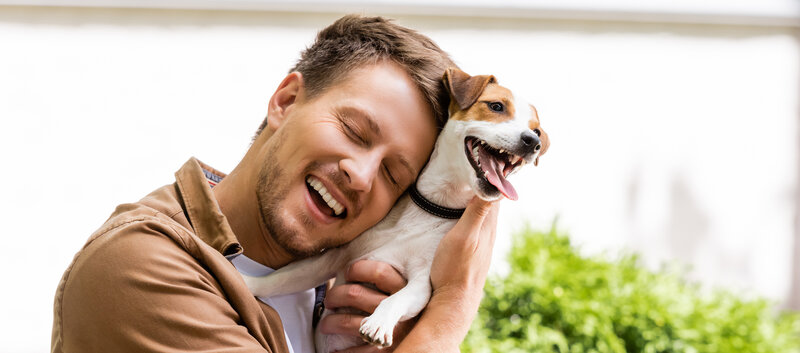
There is so much excitement around selecting a new dog and then welcoming your new companion into your home. That excitement is palpable - very much so when it comes to your sensitive dog. The more you can do to remain calm and establish a strong bond, the easier the transition will be and the better chance you’ll have of smooth sailing in the dog training realm.
Still in decision-making mode? Visit my post, What Size Dog is the Best Fit for Your Family, to guide your selection process.
While there are some small differences between welcoming a puppy versus welcoming an adult dog, the majority of these tips to build a strong bond between you and your dog are universal.
That excitement we referenced comes from a beautiful place but can also muck up the works. Suppose you bring a dog into a home where everyone is excited, loud, jumpy, and laughs or claps to encourage the puppy/dog’s less-desirable-but-humorous antics. In that case, you’re setting a stage for “disobedience.” Except, in this case, I’d say the dog isn’t disobedient at all because s/he’s following the cues from the “pack.”
Staying calm and quiet, gently setting healthy “expectations” right off the bat, creates a solid foundation for a successful, less chaotic future.
In the dog selection post I recommend above, we discuss how important it is to consider the energy level of any dog you bring into your life. Of course, a working dog can’t help that it was bred to chase and herd flocks of sheep all day, just as a Great Dane can’t help that its energy for the “boar hunt” was primarily bred out of it to create a calm, mellow personality. So, your first job is to learn all you can about your dog’s energy needs.
Regardless of breed, puppies always need plenty of energetic releases because they’re used to playing together in a pack all day. One walk per day is the minimum for most dogs. More exercise is easily accommodated by a trip to your local dog park (good for socializing as well), playing fetch, or by setting up a backyard agility course.
One of the reasons why humans and wolfs-now-dogs were so quick to bond is that we have much in common. One of those is that we thrive in order and routine, so create a daily routine for your dog and your family. This makes things predictable, which puts your dog at ease and minimizes anxiety. Routine and rhythm also support a healthy and easeful potty training journey!
Within that routine, be consistent. Inconsistency is unsettling for dogs because they are genetically wired to fall in line under a strong, confident alpha model. If you are willy-nilly, this is confusing and can allow stronger-willed dogs to begin taking over. More sensitive or submissive dogs can become anxious with inconsistent human companions, leading to separation anxiety and increased risk of destructive behavior.
As soon as a puppy gets into your house it is time to start training. For puppies below the age of 5 months make sure the training is a positive lure and reward. A puppy can learn all the basic obedience commands with mild distractions and is a great way to start the puppy on the right paw. For puppies older than 5 months we can start expecting them to do all the basic obedience with distractions. It is very important that they are enrolled right away into training.
Regardless, you should use your daily routine to begin practicing some of the most common commands/gestures - with positive, gentle reinforcement.
These include:
Consider hiring a dog trainer for a single home visit to meet your dog and your family, and then work with you to create consistent wording and gestures to streamline the process.
Dogs are playful animals. They love to run, chase, fetch, swim (some of them), wrestle, or scurry around after a Kong filled with a healthy snack (a great way to keep a high-energy dog occupied!). If you aren’t a runner or a wrestler, that’s okay. The dog park or a local doggy daycare can support that type of play.
If this is not an option then buy toys designed to withstand healthy rounds of tug-of-war that can even be played with the human in a chair if necessary. On a budget? You can tie knots in an old rope for a similar effect.
We love the ones who feed us, and dogs are no exception to this rule either. Use healthy training treats (small and in moderation) to reinforce desirable behavior and habits positively. This is also a bonding moment. Be sure to instill “polite” manners - using words such as “gentle” as you feed - and never allow the treat to be snatched or snapped at. Every dog should learn to take treats slowly and gently from a human hand.
Dogs are very physically affectionate with one another. Even adult dogs in a pack often lay down close to one another, groom each other, or lay their heads on the leg, paw, neck, etc., of a nearby companion. So take time out to cuddle with your dog each day. The great news is that studies continue to correlate human/pet cuddle time with decreased stress and anxiety.
Bonus Tip: The better trained your dog (and you!) are, the more you will bond. Consider enrolling in a group dog training class, where you’ll learn the fundamentals of building a consistent, safe, and love-filled relationship with your canine companion. Contact Alternative Canine Training to learn more.